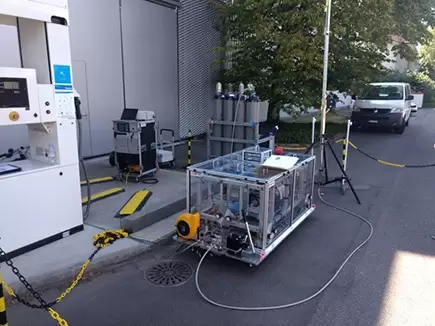
Views: 38
How to make hydrogen filling stations safer
Courtesy by EMPA | STEPHAN KÄLIN : Hydrogen mobility in Switzerland is increasing in speed. The mobility demonstration movement, which Empa opened in Dübendorf about three years ago with the support of the Swiss Federal Office of Energy (SFOE) and several industrial partners, has laid the foundations for this and has been developing continuously since So. The aim is nothing less than the decarbonization of future mobility – thanks to renewable fuels such as hydrogen.
How is mobility based entirely on renewable energy? With that question in mind, the Empa researchers started the “movement” research and demonstration platform in 2015 along with public sector and industry partners. Conceived as the charging and filling station of the future, the “movement” can be used to refuel electric vehicles, hydrogen and gas. The basis for the production of fuels is provided by the temporary excess of electricity, for example from photovoltaic systems, which otherwise could not be used directly. For electric vehicles, electricity is temporarily stored in a battery and then is also available at night at the charging points. For hydrogen-powered vehicles, an electrolysis plant converts electricity into hydrogen, known as the “energy for gas” (PtG, see box). In a further step, hydrogen could then be converted with carbon dioxide (CO 2) into a catalyst for methane (CH 4), the main component of natural gas and biogas.
As part of the “movement” and with the support of the Swiss Federal Energy Office (SFOE), H 2 Energy and Hyundai, the first two 700bar hydrogen refueling stations for passenger car refueling were built all over Switzerland in last years; the first was put into operation in October 2016 in “movement”; a month later, followed the second filling station in Hunzenschwil, built by Coop and H 2 Energy.
By establishing and operating the first hydrogen filling stations and the accompanying research, Empa, along with all its “movement” partners, laid the groundwork for various initiatives to promote hydrogen mobility in Switzerland. A few months ago, Hyundai announced its intention to deliver a total of 1000 fuel cell trucks to Switzerland in the coming years. In addition, the association “H 2 Mobility Switzerland” was founded last year and is supported by H 2 Energy as a consultant. The objective is a national network of hydrogen filling stations in Switzerland. The knowledge acquired during the first years of operation of the two existing hydrogen filling stations is immensely valuable for the development of this network.
Equal measurements throughout Europe
At the national and international level, however, there are still doubts about the ability to calibrate and measure quality at hydrogen filling stations. The determination of the exact mass and, therefore, the turnover of the replenished hydrogen is still very imprecise. As part of the “movement”, the Swiss Federal Institute of Metrology (METAS) has therefore developed a new calibration device. This calibration device and the Empa measurements are now a valuable basis for future research in the context of a European project in which several metrological institutes from different countries are involved.

Safety mechanism for hydrogen filling stations
In addition to the technical implementation and experience gained in the operation of hydrogen filling stations, Empa researchers are now also focusing on clarifying regulatory and safety issues. For example, integrating a hydrogen filling station into existing filling stations has to face a number of challenges. Since safety at a filling station has top priority, adequate safety zones are required around individual pumps. However, the filling stations should be as close as possible to save space. Current regulations lead to costly adaptations of the conventional components of the refueling station if a hydrogen filling station is installed nearby. “In cooperation with Suva, we investigate the technical possibilities to ensure safety despite the space-saving design,” says Urs Cabalzar,
One such possibility is a standard leak test before each hydrogen replenishment. “This can be used to determine if there is a leak in the fuel system between the distributor and the vehicle tank. Extensive tests and calculations on existing systems have shown under what conditions a leak test works reliably. “This makes it much easier to integrate hydrogen into conventional filling stations,” says Cabalzar. the Empa researcher.
Bringing clarity to the approval process
“In general, the approval process for hydrogen filling stations is still very confusing for both the service station builders and the specialized authorities and agencies involved,” explains Urs Cabalzar. Findings of the construction and operation of filling stations in Dübendorf and Hunzenschwil are being incorporated into a guideline explaining the approval process for hydrogen filling stations, step by step, and will soon be available. The guideline will be developed jointly with the Association of Cantonal Fire Insurers (VKF), Suva and other authorities and specialized bodies and will therefore be widely supported and accepted.
Leave a Reply